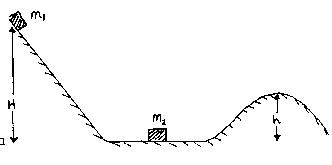Problem 3:
 A roller coaster car of mass m1 = 100 kg starts
rolling from rest at the top of a track at a height
H = 50 m. At the bottom of the hill, it collides with
another car of mass m2 = 100 kg which is initially
at rest. The two cars stick together and head for a
second hill of height h = 10 m.
A roller coaster car of mass m1 = 100 kg starts
rolling from rest at the top of a track at a height
H = 50 m. At the bottom of the hill, it collides with
another car of mass m2 = 100 kg which is initially
at rest. The two cars stick together and head for a
second hill of height h = 10 m.
-
a) What is the speed of the first car just before the collision?
- b) What is the speed of the two combined cars just after the collision?
- c) Show
whether or not they will make it to the top of the second hill.
- d) If the collision occurs in t = 0.1 s, what is the average force
exerted on the second car during the collision?
Solution:
-
a) Energy is conserved during the roll down the hill:
- Einitial = m1gH =
Efinal = (1/2)m1v12
- thus
- v1 = [2gH]1/2
- = [2(9.8 m/s2)(50 m)]1/2 =
31.3 m/s
- b) Now momentum (but not energy) is conserved during the collision of
the cars; this is just a one-dimensional perfectly inelastic collision, so
we have
- pinitial = m1v1 + 0 =
pfinal =
(m1 + m2)v
- v = [m1/(m1 + m2)]v1
- = [100 kg/(100 kg + 100 kg)](31.3 m/s) = 15.65 m/s
- c) If the combined cars are to make it to the top of the hill, their
initial kinetic energy must exceed their potential energy at the hill's top
(so that their kinetic energy at the top is > zero). Their initial kinetic
energy is
- K = (1/2)(m1 + m2)v2
- = (1/2)(200 kg)(15.65 m/s)2 = 24.5 x 103 J
- Their potential energy at the top of the second hill is
- U = (m1 + m2)gh
- = (200 kg)(9.8 m/s2)(10 m) = 19.6 x 103 J
- Thus K > U, so, yes, they will make it over the hill (with energy to spare).
- d) The impulse J is given by
- J =
 p =
Faverage
p =
Faverage t
t
- We are interested in the average force exerted on the 2nd car, so
we need to consider the change in its momentum due to the collision; its initial
momentum is zero, so its momentum change is just its final momentum which is
- p2final = m2v
- thus the average force is
- Faverage = m2v/
 t
t
- = (100 kg)(15.65 m/s)/(0.1 s) =
1.56 x 104N
- The direction of this force is in the direction of p2final,
i.e. to the right on the figure. As an aside, one could also have calculated
the momentum change of the first car to get the average force exerted on it,
and one would then get an equal (but opposite in direction) result (the 3rd
law!).
Next problem
Test 2 page
Physics 101 Home page
Physics Department Home Page
College of William and Mary,
Dept. of Physics
armd@physics.wm.edu
last updated: Oct. 20 2000
 A roller coaster car of mass m1 = 100 kg starts
rolling from rest at the top of a track at a height
H = 50 m. At the bottom of the hill, it collides with
another car of mass m2 = 100 kg which is initially
at rest. The two cars stick together and head for a
second hill of height h = 10 m.
A roller coaster car of mass m1 = 100 kg starts
rolling from rest at the top of a track at a height
H = 50 m. At the bottom of the hill, it collides with
another car of mass m2 = 100 kg which is initially
at rest. The two cars stick together and head for a
second hill of height h = 10 m.